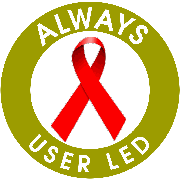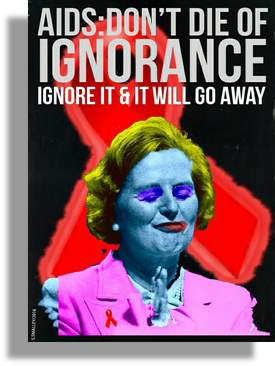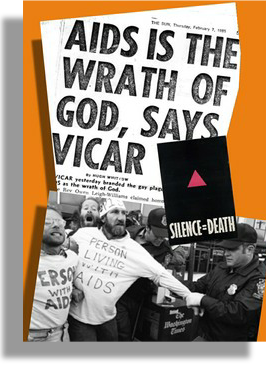NOTTINGHAM’S ONLY INDEPENDENT
VOLUNTEER RUN HIV PEER SUPPORT GROUP










REGISTERED CHARITY 1129416

© Tagadere
Registered Charity 1129416



Not in front of the children: Margaret Thatcher’s head in the sand attitude to AIDS information.
In 2016 it is still alarming yet equally unsurprising to learn that in the middle of the 1980’s the Conservative Prime Minister Margaret Thatcher attempted to block public health warnings about AIDS as she considered them to be in ‘bad taste’.
Norman Fowler, the Health Secretary at the time, submitted a memo to Thatcher about his plans to publish candid health warnings in the national Sunday newspapers about AIDS.
G overnment files which have recently been declassified after the requisite 30 year period of confidentiality are now accessible. Documentation which shows that Thatcher tried to limit the distribution of AIDS information advertisements because she believed that explicit health warnings published in the Sunday newspapers would harm young teenagers.
overnment files which have recently been declassified after the requisite 30 year period of confidentiality are now accessible. Documentation which shows that Thatcher tried to limit the distribution of AIDS information advertisements because she believed that explicit health warnings published in the Sunday newspapers would harm young teenagers.
In 1982 I was a just-
Inevitably, news updates appeared reporting that the disease had made the transatlantic leap and was beginning to take its toll on gay men in the UK.
I lived through that hideously dark period of recent history. I remember the jokes about AIDS and the spiteful acronyms for those four letters. I remember the fear and suspicion which lurked within the gay community; I certainly remember the paranoia.
The known symptoms which we read about provoked constant self-
Paranoia gripped and grew. Suddenly, what would have previously been carefree sexual encounters became liaisons tinged with feelings of risk, danger and death. As more information emerged and fear tightened its grasp, what was to become quickly known as Safe Sex became the rule and for a brief time, some gay men began to wear a safety pin on their shirt or jacket to show that they would only practise safer sex. It was a dire time filled with desperate uncertainty and anxiety.
During a 2015 documentary about the late DJ Kenny Everett, when the subject arrived at his HIV positive diagnosis and death to AIDS, fellow DJ Paul Gambaccini stated:
‘It’s impossible now for young people to imagine how horrible it was; it was discovered that it was a virus, but in those initial days you had no idea what it was nor how it was transmitted.’
Throughout this period, the majority of tabloid press ran riot amok in juvenile yet predicable homophobic style, feeding the public a constant selection of alarmist headlines. This kind of traditional tabloid attitude continued fuelling the bonfires of discrimination, confusion and ignorance which burned around the burgeoning global health crisis.
One reporter with a highly responsible position writing the horoscopes in a major UK tabloid newspaper also wrote a health column where, in one instalment, he reassured the paper’s readership that AIDS was primarily a homosexual disease. So expert was he on the subject (as well as the complex mysteries of fortune telling) he concluded his feature with the reckless line ‘So carry on bonking, folks’.
The majority of the population regarded AIDS as a gay disease; a view which had been reinforced by negligent media scare mongering which made it unsurprising to me when a neighbour’s ten year old child shouted to someone in the street who was walking past me not to bend down in front of me because they would get AIDS; obviously this had been overheard somewhere.
Many casual heterosexual male contemporaries viewed AIDS as a gay disease but at no point did they think that they could ‘get it’ from a woman unless perhaps she was an injecting drug using prostitute. They were wary that they could ‘get it’ from me.
I n early 1983 as the short countdown to my twenty-
n early 1983 as the short countdown to my twenty-
We surmised that it couldn’t as it was a virus and she also made the astute observation that until it made its crossover to the heterosexual population, gay men would continue to be blamed for AIDS. We cynically concluded that major UK financial resources would not be put into funding for finding a cure until the numbers of straight people dying to AIDS in the UK began to rise.
I was fortunate that my closest heterosexual male friends resisted believing the party line of hysteria and rejection and actually asked me for information about the disease. What little I knew in those early days was regarded as being more reliable coming from a gay man than giving credence to the lurid stories in the popular press. However, for the majority of the population, as Tom Robinson sang some five years previously in ‘Glad To Be Gay’:
‘It’s there in the papers; it must be the truth.’
There was one blip in understanding when ignorance was hurtfully exemplified for me after an evening out with two female friends from our shared childhood. At the end of our night I went to hug and kiss them goodnight as usual; the one to whom I was closest moved her face away. Apparently when I was walking off to the gay club and they were en route to a taxi rank, she announced ‘I don’t know how you can kiss him, you don’t know what he’s got. He’s probably got AIDS.’
Time moved on as the global number of AIDS deaths gathered speed and continued to rise. Thatcher dug in her heels and fought endlessly to limit the wider distribution of precise explanations of which sexual practices were more likely to lead to HIV infection; contesting references in public health information to anal intercourse and opposing the mass distribution of AIDS information leaflets to households. As if this wasn’t enough she stood against a Ministerial broadcast which would have been the first for eight years; a situation which would illustrate how serious the situation surrounding AIDS was.
Fortunately, as documents stored at the National Archives in Kew show, the Prime Minister reluctantly had to rescind most of her oppositions.
Donald Acheson, the Chief Medical Officer warned:
“The results of the infection are potentially fatal and there is no effective treatment for it. A vaccine is unlikely to be developed in the foreseeable future.”
Nevertheless, upon the completion of a £30 million blood screening laboratory in Elstree, Thatcher’s private secretary Mark Addison advised her against participating in the opening ceremony, stating “My own feeling is that the Prime Minister should stay clear of AIDS, even when it is a question of opening laboratories to help innocent victims…..If she is going to do a medical visit, I should prefer to suggest a hospital, or a home for children with incurable diseases etc.”
Health Secretary Norman Fowler proffered a memo which detailed plans for the publication of unambiguous, large format health warning advertisements in the Sunday newspapers. Despite the knowledge that the virus was contracted primarily via unprotected penetrative intercourse, this proposal evidently produced alarm as astonishingly, Thatcher added notes to the memo:
“Do we have to do the section on risky sex? I should have thought it could do immense harm if young teenagers were to read it.”
Thatcher was still not about to back down, as indicated in her annotation of one letter: “With regard to the AIDS advertisement – have we checked 1) that it is acceptable to the Advertising Standards Authority and 2) whether a check has been conducted to see that the advertisement does not fall foul of the Obscene Publications Act.”
Therefore it is not really unfeasible to think that the Prime Minister would go to the length of hoping that the advertisement would contravene the Obscene Publications Act and then she would be able to get her own way and abort the whole information campaign. Ignore it and it will go away.
A further Prime Ministerial annotation showed her determination to withhold the AIDS health education program: “I remain against certain parts of this advertisement. I think the anxiety on the part of parents and many teenagers, who would never be in danger from AIDS would exceed the good which the advertisement might do.’
There was a diluted form of acquiescence when she noted that “It would be better in my mind to follow the VD (venereal disease) precedent of putting notices in doctors’ surgeries, public lavatories etc. but”, she continued:
“…to place advertisements in newspapers, which every young person could read and learn of practices they never knew about, will do harm.”
Didn’t teenagers use public lavatories or doctors’ surgeries? Where in a doctor’s surgery would the information be placed? Presumably high upon a top shelf in a brown paper wrapper or under the counter with an attitude that it should remain unseen and embarrassing to request.
Add to the mix that Thatcher and her acolytes were formulating Clause 28 which tragically became law in May 1988 as Section 28. This foul and outrageous slice of homophobic legislation would further restrict sex education and leave a young generation bereft of information and support. In a bid to bring the matter into popular culture, Boy George released his ‘No Clause 28’ single.
In other parts of the world and thankfully here in the UK, the mobilisation of AIDS activists were reacting by demonstrating accordingly with direct action which showed Thatcher’s reticence to produce information to a mass audience as severely lacking in responsibility.
Whilst other countries were reacting assertively to the threat of AIDS by issuing uninhibited information, the 10 Downing Street policy unit warned:
“There is certainly a feeling abroad that the Government is doing too little and not treating the issue with sufficient urgency. There is also a feeling that the Prime Minister is acting as a brake on educational publicity.”
Nevertheless, Norman Fowler’s office received notification of Thatcher’s displeasure in notification stating: ‘Your secretary of state will now wish to consider how to proceed in the light of the prime minister's firmly-
This suggestion was a short step away from a cabinet minister being delivered a direct order from a civil servant, resulting in one small concession being made by the Health Secretary by replacing a section on anal sex with one single phrase.
A complimentary series of AIDS advertisements were scheduled and unfortunately the Health Department backed down, removing even that sole previous concession.
complimentary series of AIDS advertisements were scheduled and unfortunately the Health Department backed down, removing even that sole previous concession.
Documentary evidence shows that Thatcher was in agreement, no doubt happy that she had got her way as the numbers of people with AIDS continued to rise. The eventual campaign went under the blanket heading ‘AIDS: Don’t Die Of Ignorance’ yet it is scandalous to learn that Prime Minister Margaret Thatcher tried her best to keep the population ignorant about AIDS. Those dark days cannot be erased and they certainly should not be forgotten.
In 2016 I still mourn my friends who died too young, too soon.